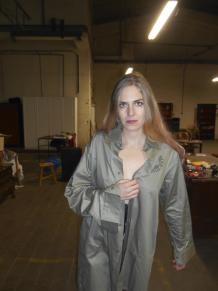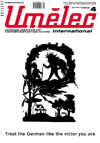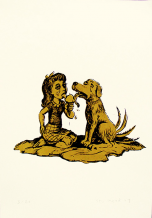| Umělec 2001/5-6 >> Maps of Thetis | Просмотр всех номеров | ||||||||||||
|
|||||||||||||
Maps of ThetisUmělec 2001/5-601.05.2001 Vladimír Borecký | focus | en cs |
|||||||||||||
|
"Two, no, in fact three maps of Thetis remain well preserved to this day. One of the three, however, has only archeological significance, the still featured continent of Nukereria having sunk beneath the ocean during a major geological catastrophe suffered by the planet Thetis long ago. And the two political maps of the little planet now have only historical value as Thetis was utterly annihilated in 1934, our time, when a comet smashed headlong into it. Well then, how exactly did the maps get here?
Dr. Jan Lukeš (1912–1977) used to tell a story. It begins one summer evening, while he was vacationing at his cottage in Solopysky near Beroun, Czechoslovakia. Dr. Lukeš was standing outside his cottage, contemplating the mysterious beauty of the stellar sky when, suddenly, he witnessed a bright flash in the sky from which a flaming object burst and plummeted into a nearby forest. Of course he ran as quickly as he could to find out what it was. When he emerged from the forest into a wide meadow he discovered a strange object still smoldering in the grass. He immediately knew that it was an interplanetary spacecraft. Within the smoking ruins he found the charred bodies of two oddly shaped creatures. As he was poking through the wreck he heard a voice groan in the distance. Without thinking he ran in the direction of the noise and found a fragment of the craft with another creature inside. He pulled it from the ruins and dragged it to his cottage with great effort; he gave first aid and kept it alive. The creature spoke no earthly language, but showed unusual clarity and high intelligence in understanding the doctor, who spoke Czech to it but also had to use a goodly bit of body language. The creature turned out to be Dahorjane Sedeno, citizen of planet Thetis and daughter of the astronomic professor Chwica Milhara. Upon hearing the news that a comet was heading for Thetis the professor decided to blast off in a spaceship of his own construction and go to planet Earth. He, his daughter, and his assistant, Darhojane’s fiancé, were the only other passengers on board. Darhojane soon mastered the Czech language and started teaching Dr. Lukeš her native Ishi language, the importance of which is comparable to the English language on Earth. Ishi is spoken in Ishuria, and it is the official language of the kingdom of Both Hesperias. This is the most important kingdom in the northern hemisphere of Thetis. Related to Ishi is the Minekar language, which is spoken in The Minekar Union, the most industrially developed country in the southern hemisphere. And very close to Ishi is Nishi, a dialect spoken on the Festive Islands (Maimatefia Wades), which are located between Hesperia and Minekar. All these forms use uniform Ishi script, which the doctor was able to pick up rather quickly. Because the doctor was an able student, Dahorjane went on to teach him the basics of other languages on Thetis. She instructed him in rudimentary Tobol, which came from the now dead language of Kvaad, but also used Ishi script. Barnum and Stehut are languages from the northern group; and Kimbel and the Sumout with their peculiar writing, were languages from the southern group. Studying the holy book of Ashrat, Doctor Lukeš came across Rythian, also a basically dead language, but which had been preserved for religious purposes by the nation of Rythians, who were living in diaspora all around the planet. He found the book in one of the bags professor Milhar had taken with him on board the spacecraft. The doctor also became familiar with Alamir of the eastern group and a number of indigenous languages. These were spoken on the distant continent of Wurfeana (the Khalimian), on the island of Patka, way up north (the Likifsachelian language), and spoken by the ancient habitants of Minekar in Idawa (the Likherian). Lukeš then immersed himself in the complex history of Thetis with all its religious and political struggles. Dahorjane practiced the religion of Ashmahs, which was the official religion in the Kingdom of Both Hesperias. The religion was based on the teachings of the prophet Mikyoli who lived at approximately the same time as Jesus Christ did on Earth. The Thetis calendar originated in Mikyoli’s lifetime and is not so different from the one we use on our planet. Before Mikyoli’s time, and in addition to the indigenous and local cults, there were two main cult streams on the planet: pagan polytheism of Stehut origin and Rythian monotheism. The Stehutan pantheon is described in detail in Books of the Northern Legend Circles. In addition to gods like Tyutyubala, Nick and Hell, and goddesses like Némi and Leila, the most supreme was the goddess of love, Rushibda, and her malicious demon Ishi chi Ishek, from whom the nation of Ishis, or Isheks, the majority nationality in Hesperia, takes its name. On the other hand, the Rythians only recognized one god, Ramurfa, and referred to the holy writing in Ashrat, keeping a very strict moral codex that carried elements of asceticism. One day, the Stehutan prince, Mikyoli, had had enough of the sensual, erotic sex cult of Rushibda, and set out to reform the religion. He wound up clashing with the clergy, who were a formidable opposition. In the end he just managed to escape with his life to Marguesdestrakhar where he befriended local Rythians, whose religion he sincerely admired. But when he wrote down his teachings in The Book of Khadish and proclaimed himself a prophet, the Rythians mercilessly nailed him to a church door and scraped off his skin. Mikyoli’s doctrine slowly began to spread throughout the Kvaad Empire. After the empire collapsed under the pressure of the Ishis in the first centuries after M., the church of Ashmahs was installed as the official religion in the state of Hesperia. A boom in neo-paganism by the Pikokloshins promoted a return to the orgiastic cult of Rushibda. But at the same time the socially motivated movement of Yuckaplibones (Bolsheviks) began to come into power, particularly in the militant state of Barnum which was controlled by Dictator Hindchurch, author of the manifesto “Power of the Steamroller.” Together with the Stehutan shuran (emperor) he declared exterminatory war on Hesperia and Minekar. The cosmic catastrophe that demolished Thetis in the 30s was a merciful boon to the rest of the universe. Despite initial resistance, Dr. Lukeš managed to convert Darhojane, who was a follower of the Ashmahs, to Christianity and asked for her hand in marriage. But before they could go through with the ceremony the Pope had to grant permission for the extraterrestrial to be baptized and married. After many lengthy delays the Vatican finally gave its blessing and on 8 September 1946 the two were married in St. Ludmila Church in Vinohrady, Prague... However, Dr. Lukeš tells another, more realistic, story about how he managed to compile 16 entirely original languages in his lifetime. According to this version, the languages were made up by Lukeš himself, starting from when he was just a precocious child. He went on to develop this version of the story and titled it The Artificial Language of Ishi, Creation of the Psychopathic Wunderkind and he ascribed authorship to his psychiatrist Jaroslav Stuhlík. The roots of the Ishi language date back to the patient’s sixth year, before he learned to write. Another phase of the language, complete with writing, dates back to the age of 11. The third phase corresponds to early adulthood, around the age of 21. Between the ages of 26 and 28, he developed the languages of Barnum and Stehut. At the age of 35, he added the languages of Kimbel, Rythian and Kreigian. And finally, between 49 and 50, he made up Kvaadian, Khalimian, Rifi-Rifi and Likherian. Dr. Lukeš’ psychiatrist, professor Jaroslav Stuchlík (1890–1967), was an exceptional figure of Czech psychiatry who was unfortunately silenced during the totalitarian regimes. He studied medicine in Zurich before WWI and worked at Prof. Eugene Bleuler’s renowned clinic in Burgholz. He was one of the pioneers of psychoanalysis in the country. Stuchlík was familiar with major cases of glossolalia and neophasia as described by T. Flournoy, J. Bobon, A. Maedr, and other top international psychiatrists. In particular he studied the famous case of Helena Smith, Théodore Flournoy’s patient, who spoke and wrote in a Martian language and drew pictures of Martian landscapes. She was an advocate of the surrealist technique of automatic drawing and writing. Lukeš, despite having created not one but sixteen languages, was never able to match her fame. Prof. Stuchlík kept his name a secret during the toughest Stalinist period of totalitarianism in the 1950s. The mutual interfusing of both versions of Ishi are documented in the collection of Lukeš’ neophasia texts entitled From the Literature of the Ishi Culture, published by Garamond publishing house in 2000. Dr. Lukeš was not only a great creator of artificial languages; he was also a poet and writer. An anthology of his poems entitled The Decadent’s Lot was published in 1999 in Brno under the pseudonym Car Osten. Prague publishing house Lege Artis is preparing his novel Across Marmokoy Afoot, a travel diary written by Panil, a major in the Hesperian gendarmerie. The shiday (king) of Both Hesperias has ordered him to suppress the spreading of yuckaplibonism in the protectorate of Marmokoy. Lukeš was also involved in politics. Following the bombing of Hiroshima in 1945, he established a Christian peace movement called Paxism, which he described in a letter to the academic Málek entitled “What Was the Paxist Coup at the Prague Castle” (Prague, 1991). He was detained for a short time by the police, and then was sent to a mental hospital. He was released six months later, but he was declared unsound of body and mind. The products of the complex and fertile mind of Jan Lukeš seemingly go on forever. His exceptional music remains unknown and under valued, particularly his 36 operas. Of note is his musical Shock-Worker, which was published in the magazine Psychiatry (1998, issue 3, pp. 169–173). The lead baritone was written for Communist President Klement Gottwald who was supposed to sing his speech in order to shock workers in the Spanish Hall of the Prague Castle in 1948. Lukeš’ continuation of Smetana’s opera, The Bartered Bride, is also noteworthy. In Lukeš’ rendition, Vašek torches the house belonging to old Mícha, and the opera concludes with the spectacular burning of the National Theater in Prague. "
01.05.2001
Рекомендуемые статьи
|
|||||||||||||
|
04.02.2020 10:17
Letošní 50. ročník Art Basel přilákal celkem 93 000 návštěvníků a sběratelů z 80 zemí světa. 290 prémiových galerií představilo umělecká díla od počátku 20. století až po současnost. Hlavní sektor přehlídky, tradičně v prvním patře výstavního prostoru, představil 232 předních galerií z celého světa nabízející umění nejvyšší kvality. Veletrh ukázal vzestupný trend prodeje prostřednictvím galerií jak soukromým sbírkám, tak i institucím. Kromě hlavního veletrhu stály za návštěvu i ty přidružené: Volta, Liste a Photo Basel, k tomu doprovodné programy a výstavy v místních institucích, které kvalitou daleko přesahují hranice města tj. Kunsthalle Basel, Kunstmuseum, Tinguely muzeum nebo Fondation Beyeler.
|






































 We Are Rising National Gallery For You! Go to Kyjov by Krásná Lípa no.37.
We Are Rising National Gallery For You! Go to Kyjov by Krásná Lípa no.37.
Комментарии
Статья не была прокомментированаДобавить новый комментарий